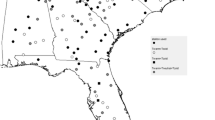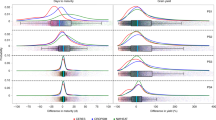Abstract
Crop models are one of the most commonly used tools to assess the impact of climate variability and change on crop production. However, before the impact of projected climate changes on crop production can be addressed, a necessary first step is the assessment of the inherent uncertainty and limitations of the forcing data used in these crop models. In this paper, we evaluate the simulated crop production using separate crop models for maize (summer crop) and wheat (winter crop) over six different locations in the Southeastern United States forced with multiple sources of actual and simulated weather data. The paper compares the crop production simulated by a crop model for maize and wheat during a historical period, using daily weather data from three sources: station observations, dynamically downscaled global reanalysis, and dynamically downscaled historical climate model simulations from two global circulation models (GCMs). The same regional climate model is used to downscale the global reanalysis and both global circulation models’ historical simulation. The average simulated yield derived from bias-corrected downscaled reanalysis or bias-corrected downscaled GCMs were, in most cases, not statistically different from observations. Statistical differences of the average yields, generated from observed or downscaled GCM weather, were found in some locations under rainfed and irrigated scenarios, and more frequently in winter (wheat) than in summer (maize). The inter-annual variance of simulated crop yield using GCM downscaled data was frequently overestimated, especially in summer. An analysis of the bias-corrected climate data showed that despite the agreement between the modeled and the observed means of temperatures, solar radiation, and precipitation, their intra-seasonal variances were often significantly different from observations. Therefore, due to this high intra-seasonal variability, a cautious approach is required when using climate model data for historical yield analysis and future climate change impact assessments.



Similar content being viewed by others
References
Asseng S (2004) Wheat crop systems: a simulation analysis. CSIRO Publisher, Melbourne. ISBN 064309119X
Baigorria GA, Jones JW, O’Brien JJ (2007) Understanding rainfall spatial variability in southeast USA at different timescales. Int J Climatol 27:749–760
Bengtsson L, Shukla J (1988) Integration of space and in situ observation to study climate change. Bull Am Meterol Soc 69:1130–1143
Carbone G, Kiechle W, Locke C, Locke C, Mearns LO, McDaniel L, Downton MW (2003) Response of soybean and sorghum to varying spatial scales of climate change scenarios in the Southeastern United States. Clim Change 60:73–98
Challinor AJ, Wheeler TR, Slingo JM, Craufurd PQ, Grimes DIF (2005) Simulation of crop yields using the ERA40 re-analysis: limits to skill and non-stationarity in weather-yield relationships. J Appl Meteorol 44:516–531
Easterling DR, Diaz HF, Douglas AV, Hogg WD, Kunkel KE, Rogers JC, Wilkinson JF (1999) Long-term observations for monitoring extremes in the Americas. Clim Change 42:285–308
Fischer RA (1979) Growth and water limitation to dryland wheat yield in Australia: a physiological framework. J Aust Int Agric Sci 45:83–94
Fowler HJ, Blenkinsop S, Tebaldi C (2007) Linking climate change modelling to impacts studies: recent advances in downscaling techniques for hydrological modeling. Int J Climatol 27:1547–1578
Gibson JK, Kållberg P, Uppala S, Nomura A, Hernandez A, Serrano E (1997) ERA Description. ECMWF re-analysis final report series, 1
Hansen JW, Jones JW (2000) Scaling-up crop models for climate variability applications. Agric Syst 65:43–72
Hargreaves GH, Samani ZA (1982) Estimating potential evapotranspiration. J Irrig Drain Eng 108:225–230
Hoogenboom G, Jones JW, Wilkens PW, Porter CH, Boote KJ, Hunt LA, Singh U, Lizaso JL, White JW, Uryasev O, Royce FS, Ogoshi R, Gijsman AJ, Tsuji GY (2010) Decision support system for agrotechnology transfer (DSSAT) Version 4.5 (CD‐ROM). University of Hawaii, Honolulu, Hawaii
Jones CA, Kiniry JR (1986) CERES-Maize: a simulation model of maize growth and development. Texas A&M University Press, College Station
Jones JW, Keating BA, Porter CH (2001) Approaches to modular model development. Agric Syst 70:421–443
Kalnay E et al (1996) The NCEP/NCAR 40-year reanalysis project. Bull Am Meteorl Soc 77:437–471
Kanamitsu M, Ebisuzaki W, Woollen J, Yang S-K, Hnilo JJ, Fiorino M, Potter GL (2002) NCEP-DOE AMIP-II reanalysis (R-2). Bull Am Meteorol Soc 83:1631–1643
Lobell DB, Burke MD (2008) Why are agricultural impacts of climate change so uncertain? The importance of temperature relative to precipitation. Environ Res Lett 3:034007
Mavromatis T, Jones PD (1999) Evaluation of HADCM2 and direct use of daily GCMdata in impact assessment studies. Clim Change 41:583–614
Mearns LO, Hulme M, Carter TR, Leemans R, Lal M, Whetton P (2001) Climate scenario development. In: Houghton JT, Ding Y, Griggs DJ, Noguer M, van der Linden PJ, Dai X, Maskell K, Johnson CA (eds) Climate change 2001: the scientific basis. Contribution of Working Group I to the Third Assessment Report of the IPCC, Cambridge University Press, Cambridge
Mearns LO, Easterling W, Hay C, Marx D (2003) Comparison of agricultural impacts of climate change calculated from high and low resolution climate change scenarios: part I. The uncertainty due to spatial scale. Clim Change 51:131–172
Olesen JE, Carter TR, Díaz-Ambrona CH et al (2007) Uncertainties in projected impacts of climate change on European agriculture and terrestrial ecosystems based on scenarios from regional climate models. Clim Change 81:123–143
Randall DA, Wood RA, Bony S et al (2007) Climate models and their evaluation. In: Solomon S, Qin D, Manning M, Chen Z, Marquis Z, Averyt KB, Tignor M, Miller HL (eds) Climate change 2007: the physical science basis. Contribution of Working Group I to the Fourth Assessment Report of the Intergovernmental Panel on Climate Change, Cambridge University Press, Cambridge
Tsvetsinskaya EA, Mearns LO, Mavromatis T, Gao W, McDaniel L, Downton W (2003) The effect of spatial scale of climatic change scenarios on simulated maize, winter wheat, and rice production in the Southeastern United States. Clim Change 60:37–71
Uppala SM, Kallberg PW, Simmons AJ, Andrae U et al (2005) The ERA-40 re-analysis. Q J R Meteorol Soc 131:2961–3012
van Ittersum MK, Leffelaar PA, van Keulen H, Kropff MJ, Bastiaans L, Goudriaan J (2003) On approaches and applications of the Wageningen crop models. Eur J Agron 18:201–234
Watson J, Challinor A (2012) The relative importance of rainfall, temperature and yield data for a regional-scale crop model. Agric Forest Meteorol. doi:10.1016/j.agrformet.2012.08.001
Acknowledgments
The authors would like to thank two anonymous reviewers for constructive comments.
Author information
Authors and Affiliations
Corresponding author
Electronic supplementary material
Below is the link to the electronic supplementary material.
Rights and permissions
About this article
Cite this article
Cammarano, D., Stefanova, L., Ortiz, B.V. et al. Evaluating the fidelity of downscaled climate data on simulated wheat and maize production in the southeastern US. Reg Environ Change 13 (Suppl 1), 101–110 (2013). https://doi.org/10.1007/s10113-013-0410-1
Received:
Accepted:
Published:
Issue Date:
DOI: https://doi.org/10.1007/s10113-013-0410-1




